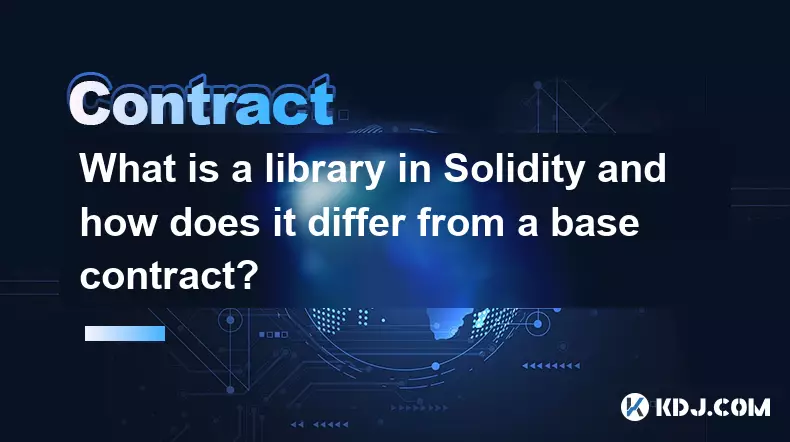-
 bitcoin
bitcoin $103128.103252 USD
-3.33% -
 ethereum
ethereum $3437.127692 USD
-4.86% -
 tether
tether $0.999700 USD
-0.02% -
 xrp
xrp $2.403993 USD
-5.73% -
 bnb
bnb $961.374676 USD
-4.11% -
 solana
solana $154.938665 USD
-8.18% -
 usd-coin
usd-coin $1.000113 USD
0.03% -
 tron
tron $0.298122 USD
0.30% -
 dogecoin
dogecoin $0.172428 USD
-5.76% -
 cardano
cardano $0.557625 USD
-7.13% -
 hyperliquid
hyperliquid $38.740701 USD
-6.51% -
 chainlink
chainlink $15.306051 USD
-7.51% -
 bitcoin-cash
bitcoin-cash $507.558648 USD
-3.26% -
 stellar
stellar $0.281899 USD
-6.74% -
 unus-sed-leo
unus-sed-leo $9.241811 USD
0.57%
How does inheritance work in Solidity smart contracts?
Solidity inheritance enables code reuse and modularity through virtual functions, multiple inheritance, and abstract contracts, but requires careful design to avoid gas costs and conflicts.
Nov 11, 2025 at 10:40 pm

Inheritance in Solidity: Building Modular Smart Contracts
1. Inheritance in Solidity allows one contract to adopt the properties and functions of another, enabling code reuse and structured design. A derived contract can inherit from a base contract, gaining access to its state variables, functions, and modifiers, provided they are not marked as private. This mechanism supports hierarchical organization of logic, reducing redundancy across multiple contracts.
2. When a contract inherits from another, it can extend or modify the inherited behavior. For example, a child contract may override functions from the parent using the virtual keyword in the base function and the override keyword in the derived one. This enables polymorphic behavior where different implementations of the same function signature can exist across contract layers.
3. Multiple inheritance is supported in Solidity, allowing a contract to inherit from more than one parent. The order of inheritance matters due to the C3 linearization algorithm used by Solidity to resolve function calls. Contracts listed first take precedence in method resolution, which helps avoid ambiguity when overlapping functions exist across parents.
4. Constructors in inherited contracts are executed in the order of inheritance, starting from the most base-level contract and moving down to the derived ones. Each constructor must be explicitly called if arguments are required, ensuring proper initialization of state variables at every level of the inheritance tree.
5. Visibility plays a crucial role in inheritance. Public and internal functions are accessible to derived contracts, while private functions remain confined to their defining contract. Internal functions can be overridden, offering flexibility for customization, whereas external functions cannot be overridden since they are only callable outside the contract context.
Function Overriding and Virtual Methods
1. To allow a function to be overridden in a derived contract, it must be declared as virtual in the base contract. This signals that the function’s implementation may be replaced in child contracts. Without this keyword, the function remains fixed and unchangeable in subclasses.
2. The overriding contract must use the override keyword when redefining a virtual function. This enforces explicit intent and prevents accidental overrides. If a function attempts to override without declaring override, the compiler will throw an error.
3. When overriding, the function signature—including name, parameters, and return types—must match exactly with the original. Modifiers such as visibility (public, internal) also need to be compatible, though stricter visibility (e.g., reducing from public to internal) is not permitted.
4. It's possible to call the parent version of an overridden function using super. This keyword routes the call through the inheritance hierarchy, invoking the next closest implementation of the function. Alternatively, BaseContractName.functionName() syntax can directly invoke a specific ancestor’s method.
5. Modifier overriding follows similar rules. A modifier can be declared virtual and then overridden in a derived contract. This allows changing pre- or post-conditions applied to functions, adapting access control or execution logic based on context.
Abstract Contracts and Interfaces
1. Abstract contracts are incomplete contracts that contain one or more functions without implementation. They are declared using the abstract keyword and serve as templates for other contracts to build upon. Any contract inheriting from an abstract contract must implement all non-implemented functions, or itself be marked abstract.
2. Functions within an abstract contract that lack a body are automatically considered abstract and must be implemented by any non-abstract child. These functions define a required interface that descendants must adhere to, ensuring consistency across implementations.
3. Interfaces take abstraction further by restricting contracts to only contain function declarations (without bodies), events, and structs. All functions in an interface are implicitly external and cannot have state variables. A contract implements an interface by providing concrete definitions for all its functions.
4. A single contract can implement multiple interfaces, combining various standardized behaviors such as ERC-20, ERC-721, or custom protocol specifications. This promotes interoperability and adherence to widely accepted standards in the Ethereum ecosystem.
5. Since interfaces cannot include constructors or inherit from regular contracts, they are best suited for defining communication boundaries between contracts rather than encapsulating reusable business logic. Their immutability makes them ideal for cross-contract interaction guarantees.
Common Pitfalls and Best Practices
1. Misordering of parent contracts during multiple inheritance can lead to unexpected behavior due to C3 linearization rules. Developers should list base contracts in decreasing order of priority to ensure correct method resolution and avoid silent bugs.
2. Overuse of deep inheritance trees can reduce readability and increase deployment costs. Flatter structures with focused, single-purpose contracts often prove more maintainable and gas-efficient than complex hierarchies.
3. Failing to mark overridable functions as virtual prevents extension in child contracts, limiting flexibility. Conversely, marking too many functions as virtual without necessity can expose unintended modification points, potentially compromising security.
4. Constructor argument mismatches in inherited chains cause compilation failures. Each constructor in the inheritance path must receive the appropriate number and type of arguments, passed explicitly during contract instantiation.
5. Relying solely on inheritance for code reuse may overlook alternatives like libraries or composability patterns. Using using for directives or delegate calls can offer safer and more modular solutions in certain scenarios.
Frequently Asked Questions
What happens if two parent contracts define a function with the same name?Solidity requires that such conflicts be resolved explicitly in the child contract. The developer must override the function and decide how to handle the ambiguity, typically by calling one of the parent versions via super or direct qualification.
Can a contract inherit from both a regular contract and an interface?Yes. A contract can inherit from multiple sources, including a mix of concrete contracts, abstract contracts, and interfaces. The same inheritance rules apply, with interfaces contributing only function signatures that must be implemented.
Is it possible to prevent a contract from being inherited?Solidity does not provide a built-in keyword like 'final' to block inheritance. However, developers can design contracts with private constructors or restrict functionality in ways that make inheritance impractical or ineffective.
How does inheritance affect gas costs during deployment?Inherited code increases the bytecode size of the resulting contract, which directly impacts deployment cost. Functions from base contracts are copied into the final bytecode unless external libraries are used, making large inheritance trees more expensive to deploy.
Disclaimer:info@kdj.com
The information provided is not trading advice. kdj.com does not assume any responsibility for any investments made based on the information provided in this article. Cryptocurrencies are highly volatile and it is highly recommended that you invest with caution after thorough research!
If you believe that the content used on this website infringes your copyright, please contact us immediately (info@kdj.com) and we will delete it promptly.
- Crypto Regulation Arrives in Brazil: Central Bank's New Rules and the Future of Digital Assets
- 2025-11-12 23:00:02
- Franklin Templeton, Benji Tech, and Canton Network: Bridging TradFi and DeFi?
- 2025-11-12 23:45:01
- Sui, Balancer, and XRP Security: Navigating the DeFi Minefield
- 2025-11-12 23:30:04
- The US Mint, Pennies, and Cancellation: A New York Minute on a Copper Conundrum
- 2025-11-12 23:30:04
- Penny for Your Thoughts? The US Mint, Canceled Coins, and What It All Means
- 2025-11-12 23:00:02
- Chinese DEX Sun Wukong: Surging Volumes and Stablecoin Reserves
- 2025-11-12 20:50:00
Related knowledge

What is a Denial of Service (DoS) attack in a smart contract and what are its common forms?
Nov 10,2025 at 05:20am
Understanding Denial of Service in Smart Contracts1. A Denial of Service (DoS) attack in the context of smart contracts refers to a scenario where a m...

What is a cryptographic nonce used for in transaction signing?
Nov 11,2025 at 05:59am
Understanding Cryptographic Nonces in Blockchain Transactions1. A cryptographic nonce is a random or pseudo-random number used only once in the contex...

How does inheritance work in Solidity smart contracts?
Nov 11,2025 at 10:40pm
Inheritance in Solidity: Building Modular Smart Contracts1. Inheritance in Solidity allows one contract to adopt the properties and functions of anoth...

What is a Minimal Proxy Contract (EIP-1167) and how does it save gas on deployment?
Nov 12,2025 at 11:39am
What is a Minimal Proxy Contract (EIP-1167)?1. A Minimal Proxy Contract, standardized under Ethereum Improvement Proposal (EIP) 1167, is a lightweight...

What is a library in Solidity and how does it differ from a base contract?
Nov 12,2025 at 09:19am
Understanding Libraries in Solidity1. A library in Solidity is a special type of contract designed to hold reusable functions that can be shared acros...

How do you safely send Ether to another contract?
Nov 09,2025 at 06:40pm
Sending Ether to Smart Contracts: Key Considerations1. Verify that the receiving contract has a payable fallback function or a designated payable func...

What is a Denial of Service (DoS) attack in a smart contract and what are its common forms?
Nov 10,2025 at 05:20am
Understanding Denial of Service in Smart Contracts1. A Denial of Service (DoS) attack in the context of smart contracts refers to a scenario where a m...

What is a cryptographic nonce used for in transaction signing?
Nov 11,2025 at 05:59am
Understanding Cryptographic Nonces in Blockchain Transactions1. A cryptographic nonce is a random or pseudo-random number used only once in the contex...

How does inheritance work in Solidity smart contracts?
Nov 11,2025 at 10:40pm
Inheritance in Solidity: Building Modular Smart Contracts1. Inheritance in Solidity allows one contract to adopt the properties and functions of anoth...

What is a Minimal Proxy Contract (EIP-1167) and how does it save gas on deployment?
Nov 12,2025 at 11:39am
What is a Minimal Proxy Contract (EIP-1167)?1. A Minimal Proxy Contract, standardized under Ethereum Improvement Proposal (EIP) 1167, is a lightweight...

What is a library in Solidity and how does it differ from a base contract?
Nov 12,2025 at 09:19am
Understanding Libraries in Solidity1. A library in Solidity is a special type of contract designed to hold reusable functions that can be shared acros...

How do you safely send Ether to another contract?
Nov 09,2025 at 06:40pm
Sending Ether to Smart Contracts: Key Considerations1. Verify that the receiving contract has a payable fallback function or a designated payable func...
See all articles










































































